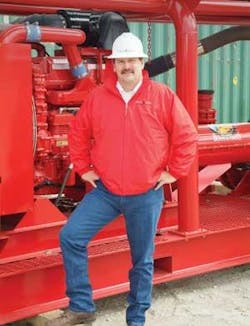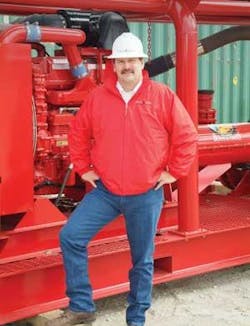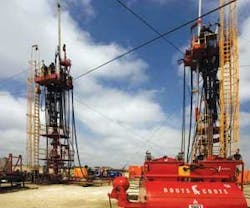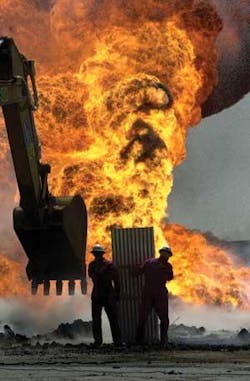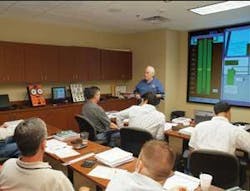Boots & Coots branches out into prevention and pressure control
AN INTERVIEW WITH Jerry Winchester, president and CEO, Boots & Coots
EDITOR’S NOTE: Jerry Winchester, president and CEO of famed well control company Boots & Coots, is a busy man these days. He travels around the globe to meet with his customers, some of whom have used his company’s emergency response services and others who participate in training and prevention services. He recently took time from his schedule to visit with OGFJ.
Don Stowers Editor, OGFJ
OIL & GAS FINANCIAL JOURNAL: First, Jerry, what is your background and how did you end up as president and CEO of Boots & Coots?
JERRY WINCHESTER: Well, I guess I’m hard-headed. I tell everybody that I’m not hard of hearing – I’m hard of listening. When I was much younger, I was living in Oklahoma and looking for a summer job. A friend told me that Halliburton was hiring summer hands and was paying something like $12.50 or $13.50. That was good money in those days, about 1981 when minimum wage was about $2.25 an hour. I had been making about $5 an hour, so I figured that I could get a job with Halliburton and more than double what I was earning. So my first job in the oil patch was driven by greed.
OGFJ: So 1981 would have been just before the big crash in the oil and gas industry.
Yes, and I was still in college at Oklahoma State. So I interviewed with the division engineer, and I did a great job of selling myself because I could see those dollar signs. Well, they sent me a letter telling me they wanted me to come to work for them and that the pay was $1250 A MONTH! This worked out to less than $4.00 an hour, so I actually took a pay cut to go to work for them. Shows you what greed will get you.
But I had already committed to come to work for them, and I was stuck. I was thinking I had signed on to be a galley slave. Or worse, a mule. One good thing though, in those days they paid for your meals, so I just thought I’d make up the difference there. I was a college kid and I could eat quite a bit.
But seriously, this was how I first got exposed to the work. My family worked in the oil field, so I knew a little about what the work was like. I grew up in southern Oklahoma out where the dirt road ends, way out in the country.
I enjoyed the work, mostly fracturing and cementing, and the people I worked with. And the company I worked for – Halliburton. Who in the world was better at doing that than Halliburton? So there was a lot of pride in that, and I got a chance to go back to work for them after I graduated.
OGFJ: What was your degree in?
Engineering technology. But the problem was that the bust had hit the oil patch. Everybody was interviewing but nobody was hiring. I figured it would be easier to get promoted than it would be to get hired, so I took a job driving a truck – an entry-level job – with Halliburton in western Arkansas. Eventually I worked my way up from the bottom of the organization to a product manager position 14 years later. In the middle of all this, I got exposed to a wide variety of things, including a stint with Halliburton’s special services unit, which did ancillary pumping and support work for well control operations. So, after all those years of being a sledge hammer technician, I finally made staff engineer.
While I was still with Halliburton, I worked with Boots & Coots in the North Sea and with the (Red) Adair Company in Venezuela, India, and the US. During the first Gulf War, I worked in Kuwait as a supervisor for Halliburton, so I worked on all those teams that were extinguishing fires set by Saddam Hussein’s people.
OGFJ: This would have been in the early ‘90s then?
That’s right. And when we came back (from Kuwait), Mr. Adair sold his company. Some of the ex-Adair people eventually bought Boots & Coots and took it public in a reverse merger. During this time, roughly the ‘93 to ‘98 period, I moved up through the ranks at Halliburton to a general manager position. I ended up as a product manager, developing and implementing strategies, first for well control and then for hydraulic workovers. And then they added to that – I did coil tubing and nitrogen as well. It turned out to be four jobs rather than one, and when I left Halliburton in October of 1998, they gave my job to four different people.
I have to tell you – I loved working for Halliburton. It was a company built on rugged individualism. Halliburton Energy Services is a little bit different of a company today. It’s a much more mature company than when I worked there.
So that’s the long, sordid story of how I ended up in the oil business.
OGFJ: Let’s move on to Boots & Coots and your role there. I heard your presentation at the Houston Energy Financial Forum last November. You mentioned that Boots & Coots had earned its reputation as a global emergency response company, but that lately your business model has changed from “sitting around waiting for the phone to ring” and you’re now stressing prevention and risk management to your clients. Can you explain how this came about?
For the first 20 years our company was in business, basically all we did was wait for the phone to ring. The company wasn’t proactive in seeking out business. Around here, we refer to it as the “funeral home business model.” That changed about 10 years ago when we made a conscious decision in about 2000 to get in the prevention business. We had to determine what our customers wanted from us and how we could help them. It really started the metamorphosis of the company.
We really wanted to take the knowledge that we gained from all those years of handling emergencies and put it to good use. How could we take what we know and do something that’s going to affect the customers in a positive way? We started in the prevention business with a lot of reservations from some of our folks, but at some point in ’04 or ’05 our prevention revenues began to outpace those from our blowout response business.
OGFJ: Was this a pretty dramatic change for everyone?
Well, yes, but we needed to change. Our blowout revenues are relatively stable at about $15 million a year. This probably isn’t going to change much. But there is plenty of room for growth in the prevention business. We can market this side of the business and we get very good results. And unlike the blowout business, we know when the revenue is going to occur. It is steady, reliable, and very easy to forecast. It’s not capital intensive, even though it’s people intensive. We’ve been fortunate that we’re able to pick up people with the right skill sets to work for us. There may be aspects of it that are the same, but no one customer is exactly alike. We fit our business to the needs of the customer, often depending on how mature the organization is or if they’re going into a new area, or if they have challenges with the competency of the crews on their rigs.
It encompasses a lot of things that are not just at the rig. For example, we’re looking at wellheads in Algeria. They’ve got LNG compression facilities scattered around and all the pipelines are running on top of the ground. And you’ve got towns going up in the middle of that. Every situation is different.
We have a lot of people coming to us all the time saying, “I want to be an oil well firefighter.” Well, the firefighting part isn’t that hard to learn. However, understanding the mechanics and hydraulics of the well is. You can’t just go out and teach somebody that in a couple of weeks. It’s exposure to it, it’s repetition, it’s seeing different kinds of situations.
When we first came out, we wanted to focus on pressure control. We had the “pressure out of control” part, but we needed to have a service component that allowed us to come in and help prevent emergency situations. It was a nice fit to where we were at the time.
Then in ‘06 we entered the hydraulic workover (HWO)/snubbing business with the acquisition of Hydraulic Well Control from Oil States, and in ‘07 we started up our pressure control rental tools service line.
A lot of our new business is a result of seeing expanding opportunity in places such as shale plays in America, which we had not taken advantage of before.
OGFJ: Could you elaborate on that? How has increased drilling and production from unconventional gas affected your business?
It’s been really good for our business, especially in the pressure control side. It fits very well with the class of equipment and operations we have. It also fits well with the prevention work that we do because of how prolific some of the wells are. Because they represent challenges in new areas of expansion, operators are moving into an area that may be a little new to them so they need to have a better sense if they have a problem, how would they handle it. We can help them with this.
OGFJ: Boots & Coots operates globally in places that potentially could pose security risks to your employees. You mentioned your work in Algeria, which has had terrorist attacks in the past. How do you deal with this?
The problems in Algeria have really subsided over the last couple of years. They’ve had a couple of election cycles that have gone relatively well. I think President [Abdelaziz] Bouteflika has done a nice job working out the differences and handling some of the issues. That doesn’t mean that they don’t have isolated incidents, but it hasn’t affected us. To my way of thinking, it’s a lot easier working in Algeria than Nigeria. I travel to Algeria all the time. Most of our work is out away from heavily populated areas. The average guy trying to cause some trouble is going to have to drive a long way to even get to us and get through multiple military checkpoints. There aren’t many roads in this remote area just north of the Sahara Desert, so it’s pretty easy to guard against this type of activity.
OGFJ: What are some of the services Boots & Coots offers?
We’ve always performed well-control contingency plans, blowout prevention plans, emergency response plans, incident command training – things like that. But we’ve had to rethink what can we do that will truly help customers reduce their risk. After we go into this as far as we can, we then go into mitigating risk, which means having our people or equipment in the country in order to respond quicker. You need to be able to very quickly go to the problem and contain it versus letting a problem escalate to the point where it really gets out of hand and you’ve got a much larger response job.
A lot of the services we provide have been tailored towards the specific needs of the customer and their particular operation. For example, some of our customers are drilling in downtown Fort Worth (Texas), which is very urban, and that has a lot different meaning than people who are drilling out in the middle of the desert.
You let a well in downtown Fort Worth get away from you, and it’s a problem, but it’s not nearly as difficult a problem to deal with as one that has 10 or 20 times the flow potential, and it becomes a little bit more technically challenging from a control standpoint.
We work with the customers and we tell them, “Here’s what we’ve done with various people in the area in similar situations.” So here’s what we would have you consider. But at the end of the day, they’ve got to choose what they think will bring them the most value.
Managing risk is not something that you can just do once. It requires continual training and preparation. Employee turnover requires ongoing training and ongoing updating of the plans. You not only need to have a plan, but everybody needs to be aware of it and there needs to be a drill to deal with it. If it’s just the proverbial big binder up on the shelf, then really, it’s not worth much. You’ve got to have a commitment to controlling your exposure to risk.
OGFJ: Where do you conduct the training?
We actually do some training downstairs in this building, but nothing beats on-site training. I don’t want people just to get the certificate. I want them to actually use the simulator to choke a well out or to kill it. They need hands-on training so that they actually are better. They don’t just look better on paper, especially with the crews. We send people out to do training on the rig with the crew. So you’re not just talking about a hypothetical situation – you’re actually there. You have to be able to identify a problem very quickly and figure out how to handle it because it can escalate pretty quickly. We try to teach awareness of this.
We do a lot of well control work over the phone. We always tell them, don’t call us when you’re standing at the cattle guard. Call us when you’re still in the dog house, and maybe we can help. Don’t wait until we can’t hear you because the well is blowing out. We help a lot of customers over the phone every day, without ever leaving the office.
OGFJ: Who are your customers?
They are everybody under the E&P sun. They come in all sizes. Domestically, one of our biggest prevention customers is Chesapeake. Internationally, it’s probably Sonatrach on the service side. We also work for BP, Devon, El Paso, Ultra Petroleum, Repsol, PDVSA, etc. The list goes on. In West Africa, Shell and Total are our biggest customers.
OGFJ: How do they hire you?
In any number of ways. Sometimes they will contract us for specific tasks. Sometimes we may do an entire plan for them. Sometimes they will give us a whole litany of things that they want to have done. Obviously a lot of this has prerequisites. You have to go in build this part, and then you’ve got to train people. So sometimes they will hire us by the task and other times by the year. Some of our work is done on three- to five-year contracts. We have many long-term relationships with people in the industry. It’s about not just being another vendor, but being a trusted advisor.
OGFJ: There’s no doubt that Boots & Coots has tremendous name recognition.
The week before last, I was in New York and was talking with a guy from one of the big investment firms there. He told me he had studied a lot of companies and that he had rarely seen a company of our size that casts as big a shadow as we do. He said, “When I see that, it just reeks of opportunity.”
I have to agree. Anyone who has been around the operations side of the oil field for a month knows who we are. We’ve become a household name – at least in the oil patch. People say things like, “That’s a Boots & Coots problem.”
OGFJ: You mentioned that Boots & Coots is now in the risk management business. Can you explain what you mean by this? Do you work with insurance providers in the part of your business that focuses on prevention?
Some of the insurance companies have taken a more proactive role in dealing with their customers in the oil and gas business, and we sometimes work with them to accomplish that. We had one of the first programs that combined risk management and prevention in the industry. Some of the insurance companies look at this as an important part of the package they offer their customers. They don’t want their customers to have blowouts.
OGFJ: Can you quantify the results of your prevention services programs?
Definitely. To use one customer, Sonatrach, as an example, we provide them with an annual report that spells out what we have done for them – what their incident rate was before our program and what it is now. They’re entitled to know, and we tell them down to the last detail.
Sonatrach told us they are proud of the fact they have shut down twice as many rigs this year as last year [due to safety concerns]. We provide them with maintenance tracking, procedure compliance, wellhead inspections – grade everything out so they can see what kind of improvements have been made.
To sum it up, they can see exactly what they are getting for their money.
OGFJ: Let me ask you about your employees. What do you look for in employees and how do you find good ones? Are they mainly engineers like yourself, people with operations experience, or both?
We hire a cornucopia of people. We have entry-level jobs we have to fill because we have jobs in our rental tool business, but the prevention business dictates that you have experienced people. So we go out and we look for people who are strong in their field and that have the kind of background that would help them represent us well and bring value to what we are doing for the customer because at the end of the day we can’t afford to have inexperienced people.
The focus of this company is on pressure control. It’s our primary focus and what we’re all about. A lot of the big oilfield service companies do so many things. They do many things well, but sometimes they struggle to do things really, really well. It’s different to have the laser-sharp focus. Our core business is pressure control, and we feel we do that extremely well.
What we’ve found out is that people who do pressure control work want to work for a pressure control-focused company – and that’s us. We’ll spend more on capex in a year on a particular service line than a larger company may spend in several years. It’s important to us to be the best in our line of work. I focus on it every day and so do our employees. I believe people who work for our competitors recognize this and call about coming to work for Boots & Coots. This is where we get many of our employees. We get people who have worked 25 or 30 years for our competitors who want to come work with us.
They don’t come to work for us because we pay better or because it will be an easy job. They come to work for us because they know that we value what they do and what they bring to the table. And we help showcase what they do. It’s like in football. Some players may play most of their careers as a second or third string player only to eventually make first string.
OGFJ: You mention your competitors. Who do you compete with?
We compete with Halliburton in certain aspects of their business, but really Cudd Energy Services and Superior are our two major competitors. Really, Cudd and Superior are our two major competitors. They have more or less the same service lines that we have. However, going back to what I said earlier, some companies – no names mentioned, of course – have so many larger service lines that they don’t concentrate on the smaller ones. They are mainly going after bigger opportunities, and pressure control may not be as important to them. It is to us. It’s who we are. Our aim is to be the biggest and the best pressure control company in the world.
OGFJ: Jerry, thanks a lot for taking time to sit down and talk with us.
